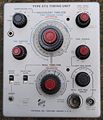5T3: Difference between revisions
Jump to navigation
Jump to search
No edit summary |
No edit summary |
||
| Line 19: | Line 19: | ||
The 5T3 can be triggered from any of four different sources: | The 5T3 can be triggered from any of four different sources: | ||
# Internal trigger from the sampling plug-in, interconnect J9. | # Internal trigger from the sampling plug-in, via interconnect J9. | ||
# Internal trigger from the calibrator module in the 661 mainframe. | # Internal trigger from the calibrator module in the 661 mainframe. | ||
# External trigger to the high-impedance BNC trigger input. This input is buffered by an [[8056]] [[nuvistor|Nuvistor]] cathode follower. | # External trigger to the high-impedance BNC trigger input. This input is buffered by an [[8056]] [[nuvistor|Nuvistor]] cathode follower. | ||
# External trigger to the 50 Ω [[GR-874]] trigger input. This input | # External trigger to the 50 Ω [[GR-874]] trigger input. This input can drive either of two selectable signal paths: | ||
# | #* A path where the trigger signal skips the high-impedance Nuvistor input buffer but is still buffered by Q64 and Q124 (1 GHz NPN transistors, part number [[151-0138-00]]) before the tunnel diode trigger event recognizer circuit. This path provides triggering up to 500 MHz. | ||
# | #* A passive low-impedance path, capacitively coupled to a tunnel diode for "UHF SYNC" mode. This works up to 5 GHz. | ||
The 5T3 can also be set to free-run mode. | The 5T3 can also be set to free-run mode. | ||
Revision as of 18:24, 9 June 2023
The Tektronix Type 5T3 is a timing plug-in for the Type 661 sampling oscilloscope. It uses TD253B tunnel diodes for triggering.
The 5T3 can be triggered from any of four different sources:
- Internal trigger from the sampling plug-in, via interconnect J9.
- Internal trigger from the calibrator module in the 661 mainframe.
- External trigger to the high-impedance BNC trigger input. This input is buffered by an 8056 Nuvistor cathode follower.
- External trigger to the 50 Ω GR-874 trigger input. This input can drive either of two selectable signal paths:
- A path where the trigger signal skips the high-impedance Nuvistor input buffer but is still buffered by Q64 and Q124 (1 GHz NPN transistors, part number 151-0138-00) before the tunnel diode trigger event recognizer circuit. This path provides triggering up to 500 MHz.
- A passive low-impedance path, capacitively coupled to a tunnel diode for "UHF SYNC" mode. This works up to 5 GHz.
The 5T3 can also be set to free-run mode.
Key Specifications
- please add
Pictures
-
front view
-
left view
-
right view
-
top view
-
bottom view
Some Parts Used in the 5T3
| Part | Part Number(s) | Class | Description | Used in |
|---|---|---|---|---|
| 151-0108-00 | 151-0108-00 | Discrete component | 350 MHz (minimum) NPN bipolar transistor | 5T3 |
| 151-0138-00 | 151-0138-00 | Discrete component | 1 GHz (minimum) NPN bipolar transistor | 5T3 |
| 1N3717 | 152-0381-00 • 152-0125-00 | Discrete component | 4.7 mA, 25 pF tunnel diode | 1L40 • 1S1 • 1S2 • 11B1 • 11B2 • 11B2A • 147A • 1470 • 148 • 21A • 22A • 3B4 • 3B5 • 408 • 432 • 434 • 453 • 453A • 454 • 466 • 491 • 5T3 • 544 • RM544 • 546 • RM546 • 547 • RM547 • 556 • RM556 • 7B70 • 7B71 • 7D11 |
| 8056 | 154-0417-00 | Vacuum Tube (Triode) | low-voltage Nuvistor triode | 422 • 502 • W • 1S1 • 3A7 • 3S3 • 3T4 • 5T3 • 10A1 |
| STD704 | 152-0125-00 | Discrete component | 4.7 mA tunnel diode | 1L40 • 1S1 • 11B1 • 11B2 • 11B2A • 147 • R147 • 147A • R147A • 1470 • 148 • R148 • 148-M • 149 • R149 • 149A • R149A • 21A • 22A • 3B4 • 3B5 • 408 • 432 • 434 • 453 • 453A • 454 • 464 • 465 • 466 • 491 • 5T3 • 544 • RM544 • 546 • RM546 • 547 • RM547 • 556 • RM556 • 7B70 • 7B71 • 7D11 |





